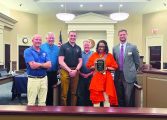By Heather Michon, correspondent
Members of the Monacan Indian Nation and their supporters appeared before the James River Water Authority on Tuesday (Aug 13) to protest a planned water pumping station atop what they believe to be the site of the historic settlement of Rassawek.
Many of the speakers made it clear they are ready to go to court if the authority refuses to move the project.
“It is clear that you will attempt to pit the taxpayers of your county against the interests of those who believe that Rassawek is too important to destroy,” said Marion Werkheiser of Cultural Heritage Partners, a law firm working with Monacan tribal leaders.
The James River Water Project (JRWP) is a multimillion-dollar joint venture between Louisa and Fluvanna counties to provide water to Zion Crossroads and other parts of Louisa County. A pumping station at Point of Fork, at the confluence of the James and Rivanna rivers near Columbia, will eventually draw over 6 million gallons of water per day to a new treatment plant near Ferncliff.
But archaeologists have long believed Point of Fork was once the village of Rassawek, one of the most culturally significant sites in Monacan history.
A 2018 archaeological survey requested by the Army Corps of Engineers on the recommendation of the Virginia Department of Historic Resources (DHR) found pottery sherds, human remains, and other artifacts dating back as far as 1200 BCE.
While this does not conclusively prove the Rassawek was once located at Point of Fork, archaeologists have called for more exploration of the site.
The Monacan tribe has been in discussions with the authority since 2017. In November 2018, they requested the authority relocate the pumping station.
In comments to the authority on Tuesday, Chief Kenneth Branham said his tribe was ready to protect the graves of their ancestors.
“We don’t know exactly where they are, could be any place in that 100 acres…and because of that, we are fighting this to the end. And we will fight this to the end,” he said. “I don’t think any of you gentlemen would like to see your grandparents and great-grandparents dug up.”
“Yes, mistakes have been made,” he added. “Man up.”
Branham was supported by Chief Frank Adams of the Upper Mattaponi Tribe, Chief Robert Gray of the Pamunkey Indian Tribe, and Earl Evans of the Haliwa-Saponi Tribe.
“Tribes are not anti-development,” Evans stressed in his remarks. “We have to live here too. We implore you to be a good neighbor.”
“These aren’t just old bones to us,” he said.
Dr. Jeffrey Hantman, professor of archaeology at the University of Virginia, has been working with the Monacan tribe for decades. He called Rassawek “the most important site in the Piedmont and it should be preserved.”
“In my opinion,” said Hantman, “no amount of proposed mitigation can balance the destructive effects of this historic site and this sacred site.”
Angelo Lomascolo, a retired lawyer living in Louisa, had some sympathy for the water authority members. “You’re here to get the financing off the books of the county, and you’re here to take the heat for stuff like this,” he said.
Lomascolo pointed out that the counties were racing against time to meet water needs for the Zion Crossroads area, and the longer it took to get water to the area, the more likely it was that there would be a water crisis.
In his opinion, getting into a legal battle over the current proposed site was counterproductive. “It’s time to find a new site. Let’s get the water up here,” he concluded. “It will be years before this litigation is over.”




